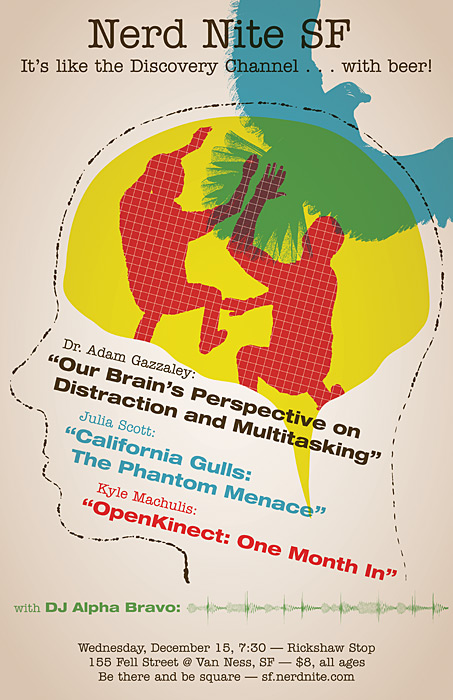
Ah, December—holiday time! With Pretend To Be a Time Traveler Day (8th), Festivus (23rd), and National Clean Up Your Computer Month (January) looming, take a little time out from your seasonal stress and enjoy our drunken, nerdy delights. Learn about your poor, multi-tasked brains (but put away the iPhones first!); discuss those scavenging scamps, seagulls; and find out how to hack the Kinect for uses that were almost certainly not imagined by Microsoft. Be there and be square!
Wednesday, 12/15
Doors @ 7:30pm, show @ 8pm
Rickshaw Stop 155 Fell St @ Van Ness
$8
—————————–
“California Gulls: The Phantom Menace” by Julia Scott
If it ever feels like seagulls get more numerous and annoying every year, guess what? It’s not just you. The Bay Area’s California gull population has exploded in recent decades, going from 24 adults in 1980 to 45,000 today. That’s a lot of mouths to feed. Biologists say the seagull baby boom presents a real and present danger for other birds the gulls target as prey. But it’s our trash habits that are fueling the gull machine—and landfills are starting to get creative about shutting them out of the garbage heap.
Julia Scott reports on birds, bees, water resources, pollution, and public health for a variety of publications. She is a staff writer with Bay Area News Group, and produces radio stories for KALW 91.7 FM in San Francisco. She recently got back from a trip to Hawaii, where there are no seagulls. www.juliascott.net
—————————–
“Our Brain’s Perspective on Distraction and Multitasking” by Dr. Adam Gazzaley
The human brain, despite extraordinary complexity and remarkable capabilities, has distinct limitations; selective attention abilities, the speed in which we process information, our short-term memory capacity, and our ability to resolve interference are all exceeded when demands are too great. Dr. Gazzaley explains how our brains manage the river of data that constantly floods it, how its capacities can be exceeded, and the consequences of this on our cognitive performance. He also presents a fascinating perspective on how our increasingly saturated world of digital media—as well as growing expectations of immediate responsiveness—place excessive demands on our brains.
Dr. Adam Gazzaley is Director of the Neuroscience Imaging Center at the University of California, San Francisco, an Associate Professor in Neurology, Physiology and Psychiatry, and Principal Investigator of a cognitive neuroscience laboratory studying the neural mechanisms of perception, attention, and memory.
—————————–
“OpenKinect – One Month In” by Kyle Machulis
On 11/4, Microsoft released their new Kinect IR camera, which allows gamers to use their bodies as controllers by combining an IR depth camera with an RGB camera. 5 days later and some bounties/hardware/drama later, the first set of open source drivers were released. Since then, the world has seen everything from point clouds to puppets to nipple tracking. This talk covers the technology that makes the camera great, and the innovation that makes the community great, and what we can expect to see in the future from this new hardware.
Kyle Machulis is an engineer working on projects ranging from haptics to driver reverse engineering to audio research to teledildonics (which is just a fancier word for haptics that people will actually pay attention to). He is currently part of the group leading the OpenKinect community in making open source, cross platform drivers for the Microsoft Kinect Camera.
—————————–
DJ Alpha Bravo is back at the decks, spinning nerdy tunage at 33 1/3, 45, and 200-500 RPMs. Alpha Bravo is VP of left-field pop label, Radio Khartoum, and was one of the forces behind legendary SF pop club nights, Anisette and Schokolade.
—————————–
Nerd Nite: “It’s like the Discovery Channel…with beer!”